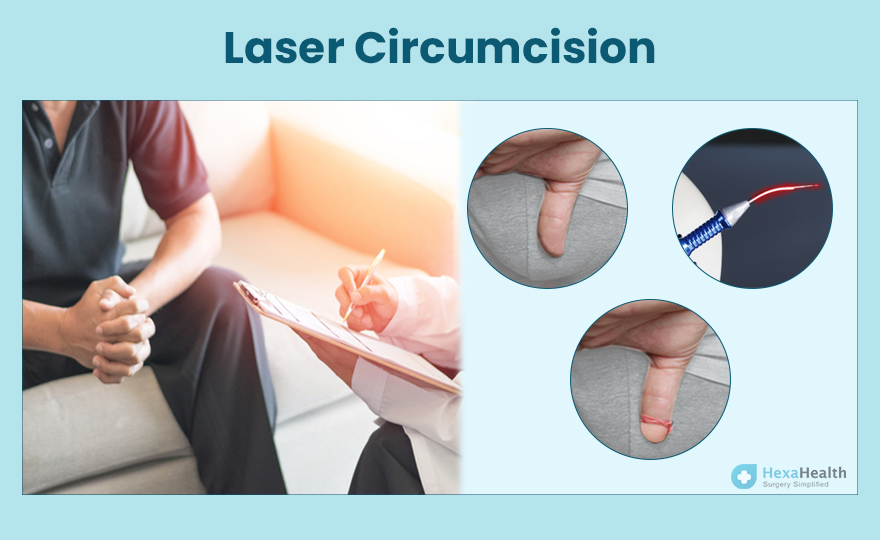Laser Circumcision: Recovery, Side Effects, Benefits, Risks
Dr. Aman Priya Khanna

Treatment Duration
10 Minutes
------ To ------20 Minutes
Treatment Cost
₹ 33,000
------ To ------₹ 41,000

Table of Contents
- What is Laser Circumcision?
- Conditions Treated with Laser Circumcision
- Who Needs Laser Circumcision?
- Laser Circumcision Procedure
- Before and on the Day of Surgery
- After Surgery and Recovery
- Benefits of Laser Circumcision
- Risks and Complications of Laser Circumcision
- Risks of Delayed Laser Circumcision
- Takeaway
Laser circumcision is a solution to remove excess foreskin using a laser. It is a minimally invasive method with numerous benefits over conventional surgical procedures.
The procedure does not negatively impact sexual function, sensitivity, sexual sensation, or satisfaction. Continue reading to discover laser circumcision cost uses, benefits, potential drawbacks, and recovery process.
Procedure Name | Laser Circumcision |
Conditions Treated | Phimosis, paraphimosis |
Benefits of Procedure | Minimally invasive, no cuts, less bleeding |
Treated By | Urologist |
You can check Laser Circumcision Cost here.
What is Laser Circumcision?
Laser circumcision is a surgical procedure that uses a high-energy laser to remove excess foreskin from the penis precisely. This minimally invasive technique treats conditions like phimosis (inability to retract foreskin) and paraphimosis (inability to return foreskin).
It offers faster healing and may cause less discomfort than traditional methods. Compared to traditional surgical methods, laser circumcision offers advantages such as quicker healing times and less discomfort.
Anatomy and Physiology
The penis is a male reproductive organ with two main functions: urination and sexual intercourse. To understand laser circumcision better, take a look at the key anatomical parts involved:
Shaft (Body): It is a cylindrical structure containing erectile tissue.
Glans (Head): The rounded tip of the penis, covered in sensitive skin. It also contains the urethral opening.
Foreskin (Prepuce): A loose fold of skin that partially or fully covers the glans.
Beyond its anatomical structure, the foreskin also plays a role in the functionality of the penis:
Foreskin Function: The foreskin protects the glans from irritation and injury. It also helps maintain moisture during sex.
Retraction: During development, the foreskin loosens naturally, allowing it to retract and expose the glans completely. In some cases, this retraction may be limited (phimosis).
Laser Circumcision Videos by HexaHealth
Expert Doctors (10)
NABH Accredited Hospitals (10)
Laser Circumcision Success Stories


Conditions Treated with Laser Circumcision
Laser circumcision has emerged as a modern approach to addressing concerns related to the foreskin. While the foreskin plays a role in protecting the glans, some men may experience medical conditions. This procedure is beneficial for addressing:
Phimosis: It occurs when the foreskin remains tight, making it difficult to retract and expose the glans. Phimosis can cause pain, inflammation, and difficulty with urination.
Paraphimosis: This is a medical emergency where the retracted foreskin gets trapped behind the glans and cannot be returned to its original position. Paraphimosis can cause swelling and pain and restrict blood flow to the glans.
Balanitis: It is an inflammation of the glans penis. Laser surgery can be an option in severe cases where hygiene is difficult due to a tight foreskin.
Posthitis: This is a condition wherein the foreskin is inflamed, making it necessary to consider laser circumcision.
Who Needs Laser Circumcision?
While the decision to undergo this procedure is personal, some men might consider it for specific medical reasons. Following are some situations where laser circumcision may be a potential solution:
Difficulty or inability to retract the foreskin due to tightness.
A trapped foreskin behind the glans requires immediate medical attention.
Recurrent or severe inflammation of the glans or foreskin, especially when a tight foreskin compromises hygiene.
Laser Circumcision Procedure
Laser circumcision is a minimally invasive surgical procedure that takes 15-30 minutes. Below are the steps involved in the procedure:
Patient Positioning: The patient will be comfortably positioned on an operating table, lying flat on their back or on slightly elevated legs.
Anaesthesia: General anaesthesia is administered to ensure comfort throughout the procedure.
Preparation: To minimise the risk of infection, the surgical area will be thoroughly cleaned and sterilised with an antiseptic solution. A sterile drape will be positioned around the area.
Laser Ablation: The surgeon uses a specialised laser to target and remove the excess foreskin precisely. The laser beam burns blood vessels as it cuts, minimising bleeding.
Monitoring: Vital signs, such as heart rate, oxygen levels, and blood pressure, will be monitored to ensure the patient’s safety.
Wound Closure: In some cases, dissolvable stitches may close the wound. Alternatively, depending on the size and location of the incision, the wound may be left open to heal naturally.
Before and on the Day of Surgery
While the procedure is relatively quick, proper preparation is crucial for a smooth experience and optimal healing. The following is what patients can expect before and on the day of the surgery:
Before the Surgery
Laser circumcision offers a potential solution for various medical concerns. However, undergoing any surgery requires careful planning and understanding. The following are the things to consider before the surgery:
Pre-op Assessments |
|
Risk Evaluation | 1. Infection 2. Risk vs Benefits |
Anesthesia | General anaesthesia |
Preparation Instructions | 1. Stop blood thinner medications 2. Follow fasting for 8-12 hours beforehand 3. Maintain hygiene as instructed |
On the Day of Surgery
Arrive on time, as mentioned by the surgeon, and complete all the paperwork. There are several other things to expect on the day of the surgery.
Parameters | Prerequisites |
Consent | Mandatory |
Surgical Preparation | Changing into a hospital gown |
Physical Evaluation | 1. Vital signs check (blood pressure, heart rate, temperature, and oxygen levels) 2. Examination of the penis for signs of infection or inflammation |
IV Line | Yes |
Patient Position | Supine (lying on the back with face up) or lateral decubitus (lying on the side) |
After Surgery and Recovery
The laser circumcision recovery time is generally 2-3 weeks. Following laser circumcision, the patient will go through the following phase:
In the Hospital
After surgery, the condition will be monitored in the recovery room for vitals, anaesthesia effects, and pain management. Depending on their recovery, the patient might be discharged on the same day.
At Home
Once discharged, recovery continues at home. Below are a few important things to follow for a quick recovery time:
Diet and Lifestyle: Follow the doctor's diet and activity level instructions. Avoid strenuous activity and prolonged sitting for optimal healing.
Wound Care: Proper wound care is crucial. This may include:
Skip baggy boxer shorts and opt for snug-fitting underwear that provides support to the penis during healing. This helps minimise swelling and discomfort.
Keeping the area dry and applying petroleum jelly to the tip of the penis to minimise irritation during urination.
3. Pain Management: The doctor will prescribe medication to manage discomfort.
4. Restrictions: Avoid sexual activity for 2-3 weeks after surgery, as instructed by the doctor.
5. Drinking Plenty of Fluids: Drink plenty of water throughout the day to stay hydrated. This helps ease discomfort during urination and flushes out bacteria that could cause infection.
6. Bathing: Take baths, but wait at least two days after surgery before a full body wash. Avoid cleaning the incision site directly during full-body baths for the first few days.
First Follow-up Appointment
The doctor will determine the timing of the first follow-up appointment. During this visit, they will likely:
Examine the healing process
Order diagnostic tests if needed
Prescribe any necessary medication for continued healing
Provide further follow-up instructions
Benefits of Laser Circumcision
Laser circumcision offers several advantages over traditional surgical methods for addressing foreskin concerns. The following are the key benefits of this procedure:
Compared to traditional scalpel techniques, laser circumcision utilises a precise laser beam. It minimises tissue damage and bleeding.
The minimally invasive nature of laser surgery often translates to quicker healing times.
Laser technology helps minimise pain during the procedure itself.
The laser beam cauterises blood vessels as it cuts, leading to less bleeding during and after surgery.
Laser circumcision removes excess foreskin, making it easier to maintain proper hygiene. It also reduces the risk of infections.
Circumcision may be associated with a lower risk of urinary tract infections in males.
Laser circumcision offers a more precise and potentially more cosmetically appealing outcome.
Risks and Complications of Laser Circumcision
Like any surgery, this surgical method carries potential risks and complications. While uncommon, it's essential to be aware of laser circumcision disadvantages and risks before making a decision.
Signs of infection like redness, increased pain, swelling, pus drainage, or fever.
Due to the cauterising effect of the laser, bleeding can occur during or after the procedure.
Swelling and discomfort around the penis after surgery are possible, which subside within a few days.
Temporary difficulty urinating may occur due to swelling or irritation.
While uncommon, scar tissue formation can occur at the incision site.
In rare cases, the removal of the foreskin may not be complete, requiring a second procedure.
Risks of Delayed Laser Circumcision
While laser circumcision is typically a safe procedure, delaying it in some cases may lead to potential complications. These are the reasons why timely action might be advisable:
Recurrent Infections: Delayed circumcision, in case of frequent infections underneath the foreskin, leads to a higher risk of infections.
Increased Discomfort: Delaying the procedure may prolong any discomfort or hygiene concerns associated with the foreskin.
Cost of Laser Circumcision
Before preparing for the procedure, it is important to discuss the price with the surgeon. The laser circumcision cost in India can vary depending on several factors. Below are the details for the expenses:
Laser Circumcision | Estimated Cost |
Minimum | ₹30,000 |
Average | ₹37,000 |
Maximum | ₹41,000 |
Factors Affecting Cost
There are numerous factors influencing the overall cost of laser circumcision, including:
City and Hospital: The location and type of hospital (government, private, multi-specialty) can affect the cost. Procedures in metro cities tend to be more expensive than those in smaller towns.
Surgeon's Fees: The surgeon's experience and qualifications can affect their fees.
Anaesthesia Type: General anaesthesia typically costs more than local anaesthesia.
Post-operative Care: The duration of hospital stay and any follow-up visits can impact the cost.
Takeaway
Laser circumcision offers a potentially faster-healing, minimally invasive approach to foreskin concerns. It can address hygiene issues, manage conditions like phimosis, and potentially reduce UTI risks. Talk about the benefits and risks with the doctor to determine if it's right for you.
HexaHealth can be your partner in finding the best healthcare facility. Our platform helps you find experts in laser circumcision near me and schedule consultations tailored to your needs. Take charge of your health journey - reach out to HexaHealth today!
Suggested Reads
Frequently Asked Questions (FAQ)
What is laser circumcision?
Laser circumcision is a surgical procedure that removes the foreskin of the penis using a high-energy laser beam. This minimally invasive technique offers quicker healing times and less discomfort than traditional surgical methods.
How much does laser circumcision cost?
Laser circumcision cost in India typically ranges from ₹30,000 to ₹41,000. Several factors can affect the price, including surgeon's fees, hospital charges, and anaesthesia type.
Where can I find a laser circumcision specialist near me?
HexaHealth can help! We can assist you in finding experts for laser circumcision near me. Our platform connects you with a network of qualified doctors and healthcare facilities.
How is laser circumcision different from traditional circumcision?
Traditional circumcision uses a scalpel to remove the foreskin, while laser circumcision uses a laser. This offers several advantages:
Minimally invasive: Less tissue damage and bleeding
Faster healing: Quicker recovery time and potentially less discomfort
Reduced pain: Laser technology minimises pain during the procedure
What is the recovery time after penis skin surgery?
The recovery time following penis skin surgery is around 2-3 weeks. This may involve:
Minimal swelling and discomfort were managed with medication
Wearing supportive underwear for optimal healing
Keep the incision clean and dry as instructed by the doctor
Are there any side effects of laser circumcision?
Just like any other surgery, this minimally invasive technique also has a few side effects. Laser circumcision side effects are as follows:
Signs include redness, swelling, increased pain, or pus drainage
Although uncommon, excessive bleeding should be reported to the doctor
Temporary difficulty in urination due to swelling or irritation
Is laser circumcision safer than traditional circumcision?
Both procedures are generally safe. However, laser circumcision offers some potential advantages:
Less bleeding due to the laser cauterising blood vessels
Reduced risk of infection due to minimal tissue damage
What are the benefits of laser circumcision?
The advantages of this procedure make it a preferred solution for excess foreskin removal. Compared to the traditional surgical procedure, laser circumcision offers several benefits.
Faster healing and potentially less discomfort
Reduced pain during the procedure
Improved hygiene due to easier cleaning of the penis
Potential reduction in urinary tract infections
What are the risks of laser circumcision?
Generally, laser circumcision comes with minimal to no risks. Even though a minimally invasive technique, there are a few possible risks, including:
Infection
Bleeding
Difficulty urinating
Can laser circumcision help with phimosis?
Yes, laser circumcision can be an effective treatment for phimosis, a condition where the foreskin tightens and cannot retract fully. It removes the excess foreskin, allowing the foreskin to retract normally.
How much does phimosis surgery cost on average?
Is laser circumcision covered under insurance?
Most insurance policies cover circumcision charges. However, coverage for laser circumcision can vary depending on the specific plan. It's recommended that you contact HexaHealth to determine coverage details.
Are there any age restrictions for laser circumcision?
Laser circumcision can be performed on infants, children, adolescents, and adults. A doctor can advise on the suitability based on individual circumstances.
Laser Circumcision Cost Videos
References
All the articles on HexaHealth are supported by verified medically-recognized sources such as; peer-reviewed academic research papers, research institutions, and medical journals. Our medical reviewers also check references of the articles to prioritize accuracy and relevance. Refer to our detailed editorial policy for more information.
- Penis anatomy: Functions and common conditions [Internet]. www.medicalnewstoday.com. 2021.

- Recovery after a Laser Circumcision: What to Expect [Internet]. www.apollospectra.com. [cited 2024 Apr 25].

- Admin_drazharalam. Laser Circumcision Advantages and Disadvantages [Internet]. Dr Azhar Alam. 2022 [cited 2024 Apr 25].

Last Updated on: 5 February 2025
Reviewer

Dr. Aman Priya Khanna
MBBS, DNB General Surgery, Fellowship in Minimal Access Surgery, FIAGES
14 Years Experience
Dr Aman Priya Khanna is a well-known General Surgeon, Proctologist and Bariatric Surgeon currently associated with HealthFort Clinic, Health First Multispecialty Clinic in Delhi. He has 14 years of experience in General Surgery, Proctolo...View More
Author

She has extensive experience in content and regulatory writing with reputed organisations like Sun Pharmaceuticals and Innodata. Skilled in SEO and passionate about creating informative and engaging medical conten...View More
Laser Circumcision Cost in Top Cities

































